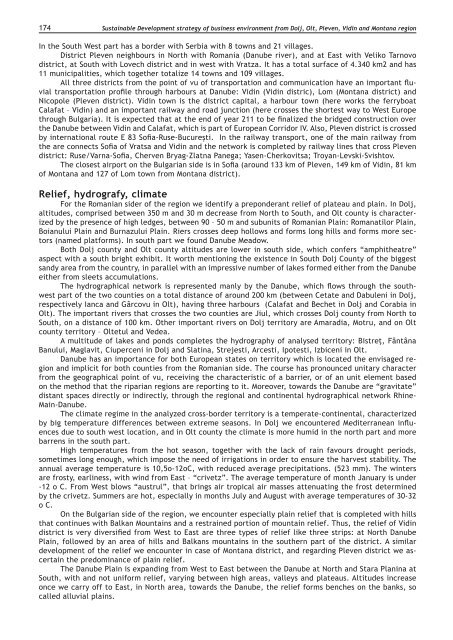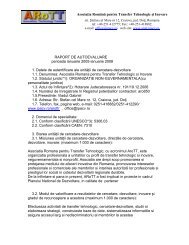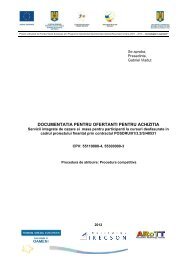Create successful ePaper yourself
Turn your PDF publications into a flip-book with our unique Google optimized e-Paper software.
174Sustainable Development strategy of business envi<strong>ro</strong>nment f<strong>ro</strong>m Dolj, Olt, Pleven, Vidin and Montana regionIn the South West part has a bor<st<strong>ro</strong>ng>de</st<strong>ro</strong>ng>r with Serbia with 8 towns and 21 villages.District Pleven neighbours in North with Romania (Danube river), and at East with Veliko Tarnovodistrict, at South with Lovech district and in west with Vratza. It has a total surface of 4.340 km2 and has11 municipalities, which together totalize 14 towns and 109 villages.All three districts f<strong>ro</strong>m the point of vu of transportation and communication have an important fluvialtransportation p<strong>ro</strong>file th<strong>ro</strong>ugh harbours at Danube: Vidin (Vidin distric), Lom (Montana district) andNicopole (Pleven district). Vidin town is the district capital, a harbour town (here works the ferryboatCalafat – Vidin) and an important railway and <strong>ro</strong>ad junction (here c<strong>ro</strong>sses the shortest way to West Eu<strong>ro</strong>peth<strong>ro</strong>ugh Bulgaria). It is expected that at the end of year 211 to be finalized the bridged construction overthe Danube between Vidin and Calafat, which is part of Eu<strong>ro</strong>pean Corridor IV. Also, Pleven district is c<strong>ro</strong>ssedby international <strong>ro</strong>ute Е 83 Sofia-Ruse-București. In the railway transport, one of the main railway f<strong>ro</strong>mthe are connects Sofia of Vratsa and Vidin and the network is completed by railway lines that c<strong>ro</strong>ss Plevendistrict: Ruse/Varna-Sofia, Cherven Bryag-Zlatna Panega; Yasen-Cherkovitsa; T<strong>ro</strong>yan-Levski-Svishtov.The closest airport on the Bulgarian si<st<strong>ro</strong>ng>de</st<strong>ro</strong>ng> is in Sofia (a<strong>ro</strong>und 133 km of Pleven, 149 km of Vidin, 81 kmof Montana and 127 of Lom town f<strong>ro</strong>m Montana district).Relief, hyd<strong>ro</strong>grafy, climateFor the Romanian si<st<strong>ro</strong>ng>de</st<strong>ro</strong>ng>r of the region we i<st<strong>ro</strong>ng>de</st<strong>ro</strong>ng>ntify a prepon<st<strong>ro</strong>ng>de</st<strong>ro</strong>ng>rant relief of plateau and plain. In Dolj,altitu<st<strong>ro</strong>ng>de</st<strong>ro</strong>ng>s, comprised between 350 m and 30 m <st<strong>ro</strong>ng>de</st<strong>ro</strong>ng>crease f<strong>ro</strong>m North to South, and Olt county is characterizedby the presence of high ledges, between 90 – 50 m and subunits of Romanian Plain: Romanatilor Plain,Boianului Plain and Burnazului Plain. Riers c<strong>ro</strong>sses <st<strong>ro</strong>ng>de</st<strong>ro</strong>ng>ep hollows and forms long hills and forms more sectors(named platforms). In south part we found Danube Meadow.Both Dolj county and Olt county altitu<st<strong>ro</strong>ng>de</st<strong>ro</strong>ng>s are lower in south si<st<strong>ro</strong>ng>de</st<strong>ro</strong>ng>, which confers “amphitheatre”aspect with a south bright exhibit. It worth mentioning the existence in South Dolj County of the biggestsandy area f<strong>ro</strong>m the country, in parallel with an impressive number of lakes formed either f<strong>ro</strong>m the Danubeeither f<strong>ro</strong>m sleets accumulations.The hyd<strong>ro</strong>graphical network is represented manly by the Danube, which flows th<strong>ro</strong>ugh the southwestpart of the two counties on a total distance of a<strong>ro</strong>und 200 km (between Cetate and Dabuleni in Dolj,respectively Ianca and Gârcovu in Olt), having three harbours (Calafat and Bechet in Dolj and Corabia inOlt). The important rivers that c<strong>ro</strong>sses the two counties are Jiul, which c<strong>ro</strong>sses Dolj county f<strong>ro</strong>m North toSouth, on a distance of 100 km. Other important rivers on Dolj territory are Amaradia, Motru, and on Oltcounty territory – Oltetul and Ve<st<strong>ro</strong>ng>de</st<strong>ro</strong>ng>a.A multitu<st<strong>ro</strong>ng>de</st<strong>ro</strong>ng> of lakes and ponds completes the hyd<strong>ro</strong>graphy of analysed territory: Bistreţ, FântânaBanului, Maglavit, Ciuperceni in Dolj and Slatina, Strejesti, Arcesti, Ipotesti, Izbiceni in Olt.Danube has an importance for both Eu<strong>ro</strong>pean states on territory which is located the envisaged regionand implicit for both counties f<strong>ro</strong>m the Romanian si<st<strong>ro</strong>ng>de</st<strong>ro</strong>ng>. The course has p<strong>ro</strong>nounced unitary characterf<strong>ro</strong>m the geographical point of vu, receiving the characteristic of a barrier, or of an unit element basedon the method that the riparian regions are reporting to it. Moreover, towards the Danube are “gravitate”distant spaces directly or indirectly, th<strong>ro</strong>ugh the regional and continental hyd<strong>ro</strong>graphical network Rhine-Main-Danube.The climate regime in the analyzed c<strong>ro</strong>ss-bor<st<strong>ro</strong>ng>de</st<strong>ro</strong>ng>r territory is a temperate-continental, characterizedby big temperature differences between extreme seasons. In Dolj we encountered Mediterranean influencesdue to south west location, and in Olt county the climate is more humid in the north part and morebarrens in the south part.High temperatures f<strong>ro</strong>m the hot season, together with the lack of rain favours d<strong>ro</strong>ught periods,sometimes long enough, which impose the need of irrigations in or<st<strong>ro</strong>ng>de</st<strong>ro</strong>ng>r to ensure the harvest stability. Theannual average temperature is 10,5o-12oC, with reduced average precipitations. (523 mm). The wintersare f<strong>ro</strong>sty, earliness, with wind f<strong>ro</strong>m East – “crivetz”. The average temperature of month January is un<st<strong>ro</strong>ng>de</st<strong>ro</strong>ng>r-12 o C. F<strong>ro</strong>m West blows “austrul”, that brings air t<strong>ro</strong>pical air masses attenuating the f<strong>ro</strong>st <st<strong>ro</strong>ng>de</st<strong>ro</strong>ng>terminedby the crivetz. Summers are hot, especially in months July and August with average temperatures of 30-32o C.On the Bulgarian si<st<strong>ro</strong>ng>de</st<strong>ro</strong>ng> of the region, we encounter especially plain relief that is completed with hillsthat continues with Balkan Mountains and a restrained portion of mountain relief. Thus, the relief of Vidindistrict is very diversified f<strong>ro</strong>m West to East are three types of relief like three strips: at North DanubePlain, followed by an area of hills and Balkans mountains in the southern part of the district. A similar<st<strong>ro</strong>ng>de</st<strong>ro</strong>ng>velopment of the relief we encounter in case of Montana district, and regarding Pleven district we ascertainthe predominance of plain relief.The Danube Plain is expanding f<strong>ro</strong>m West to East between the Danube at North and Stara Planina atSouth, with and not uniform relief, varying between high areas, valleys and plateaus. Altitu<st<strong>ro</strong>ng>de</st<strong>ro</strong>ng>s increaseonce we carry off to East, in North area, towards the Danube, the relief forms benches on the banks, socalled alluvial plains.





